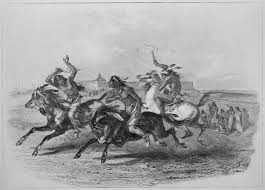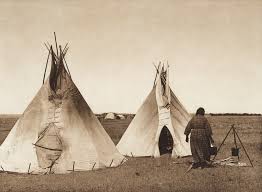The Great Sioux Nation and Lakota People Reservations

The Great Sioux Nation or the Great Plains Indians was the political structure system followed by the Sioux in North America during the occupation of Europeans and Euro-Americans in the region. It covered the whole South Dakotan state and some of its nearby states. This tribal system was composed of Siouan-speaking people who were also members of Oceti Sakowin or the Seven Council Fires.
This large Sioux council was composed of three tribal regions namely Dakota, Nakota, and the Lakota Tribe . Each division has several bands in it which hosts various groups speaking in distinct dialects from the other.
Santee-Sisseton (Dakota)
Santee-Sisseton, or simply Dakota, was mainly composed of knife makers called Isanti or Santee. This division has four subgroups which speak the native Dakotan dialect. These include the Mdewankanton or Dwellers by the Sacred Lake, Wahpetonwan or Dwellers among the Leaves, Wahpekute or Shooters among the Leaves, and Sisseton or People of the Marsh.
Ihanktown-Ihanktowana (Nakota)
This is considered as the smallest Sioux division of Native Americans which speaks the Nakota dialect and was recognized as the Keepers of the Sacred Pipestone. Nakota has two bands called Ihanktowana or Upper Yanktonai - also known as the Little End Village, and the Ihanktown or Lower Yanktonia - also called the End of the Camp Circle.
Teton Sioux (Lakota)
Lastly, the most number of bands belongs to Teton Sioux or Lakota. They are also called the Tetonwans or the Dwellers of the Plains which currently has seven sub-tribes speaking the distinct Lakota dialect or Lakotiyapi.
1. Sicangu or Brule', also known as the Burnt Thigh
2. Hun'kpapa, also known as the Campers at the Horn
3. Oohenumpa, also known as the Two Kettles
4. Sihasapa, also known as the Blackfeet
5. Itazipo or Sans Arc, also known as the Without Bows
6. Mnicoujou, also known as the Planters by the River
7. Oglala, also known as the Scatter Their Own
As far as the history of the Lakota goes, the tribe initially occupied the western area of the Missouri River then later moved in the Ohio Valley. The group then found home and settled on Paha Sapa or the Black Hills. Early Lakota considered this as a sacred place and clearly opposes any mining activities in the area.
In 1868, the Fort Lamarie Treaty was introduced and enacted by the United States government protecting Black Hills from any descendants and outside settlements. However, gold was discovered in the area a few years later which resulted to a great dispute between the US Army and Lakota called the Great Sioux War.
The war lasted until 1877 where the Lakota, together the Arapaho and the Northern Cheyenne, fell into the hands of the United States government. They were eventually sent into reservations, barred them from hunting, and forced them to accept food distributions from the US government. Some of their prominent leaders like Spotted Elk and Sitting Bull were also killed in these reservations while still fighting for their right on Black Hills.
Today, Lakota tribes are now distributed in different reservations around South Dakota.
Pine Ridge Indian Reservation

The Pine Ridge Indian Reservation, also known as the Pine Ridge Agency, is the home of the Oglala group located in the southwestern corner the South Dakota region. It was established in 1889 on the border of Nebraska which has now a land area amassing to 3,468.85 square miles or 8,984.3 square kilometers. It is currently the eight biggest reservation land located in the United States, larger than the combined land areas of Rhode Island and Delaware.
Despite its huge land area, Pine Ridge only utilize 84,000 acres or 340 square kilometers of land for agriculture. Moreover, 80% of their population is unemployed and 49% of them are living below the poverty line. They also have high mortality rates and numerous cases of drug abuse, alcoholism, and malnutrition in their region. Most of their households also don't have their own electricity and water sources, as well as reliable sewage and communication systems. These issues and concerns eventually tag them as one of the poorest countries in United States.
Rosebud Indian Reservation
On the other hand, the Rosebud Indian Reservation or RIR was established in 1889 to house the Sicangu or the Brule' tribe, which are also known as the Rosebud Sioux Tribe (RST). The RIR region currently includes the entire Todd Country in South Dakota and some areas in four adjacent provinces. Compared with Pine Ridge tribe, the RST was somehow successful in growing its economy and managing their services for their own people.
The tribe currently operates its own casino, the Rosebud Casino, which is powered by wind turbines. They have also built a residential complex called the Sicangu Village which is located near the casino. It has also developed its own university, the Sinte Gleska University, which was named after their great leader, Spotted Tail.
Standing Rock Indian Reservation
The Standing Rock Indian Reservation houses the Hun'kpapa and Sihasapa tribes from Lakota, as well as the Yanktonai group from Dakota. It is considered the sixth largest Native American reservation in the United States with a land area of almost 3,600 square miles or 9,300 square kilometers in North and South Dakota. Standing Rock Reservation currently has 8,217 inhabitants in its entire region.
Cheyenne River Indian Reservation
Also called as Cheyenne River Sioux Reservation, this is the fourth largest land reservation in the United States with a total land area of about 4,300 square miles or 11,000 square kilometers. It is the current home of the Oohenumpa, Itazipo, Mnicoujou tribes and some other communities which are thriving in several counties in South Dakota.
